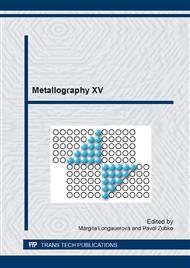p.201
p.205
p.209
p.215
p.221
p.227
p.231
p.235
p.239
Defects and Particles in Laboratory Hot Rolled Steel of C-Mn-Cr-Nb Type
Abstract:
Susceptibility to cracking of the as-cast C-Mn-Cr-Nb steel was studied by laboratory rolling. The variable parameters were the heating temperature (1150 - 1340 °C) as well as the rolling temperature (950 - 1150 °C). Final microstructure of the free-cooled samples was constituted by bainite, pearlite and ferrite with different morphology and various contribution. Deformation temperature below 1000 °C yielded in the incomplete recrystallization of austenite. Surface cracks originated preferentially on the austenite grains boundaries. Size of the present particles (inclusions and precipitates) varied from 101 nm to 101 μm. SEM and EDS analysis revealed that the inclusions ware mostly of the MnS type. TEM analysis confirmed that the grain boundaries were not enriched by any particles. In addition to the Fe3C particles, the discoid niobium carbide particles with approximately 40 nm diameter and 10 nm thickness were detected. These small particles were not connected by any notable pinning of dislocations.
Info:
Periodical:
Pages:
221-226
Citation:
Online since:
April 2014
Price:
Сopyright:
© 2014 Trans Tech Publications Ltd. All Rights Reserved
Share:
Citation:


